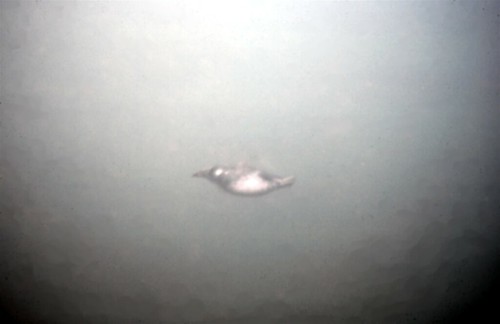tags: Ancient Murrelet, Synthliboramphus antiquus, birds, mystery bird, bird ID quiz
[Mystery bird] Ancient Murrelet, Synthliboramphus antiquus, photographed zigzagging rapidly roughly 15m below the waves off the south side of Alki Point, Seattle, Washington. [I will identify this bird for you in 48 hours]
Image: Ron Shimek [larger view].
Olympus OM-10 in an Ikelite Housing, Kodachrome 64 film.
Please name at least one field mark that supports your identification.
This poorly-known mystery bird species has two remarkable behaviors that are thought to reduce predation at the nest -- what are they?
These small auks arrive at and depart from their nests at night, presumably to reduce predation. They also never feed their young at the nest, instead, taking them to sea 1-3 days after hatching. After the newly hatched chicks run to the sea from their nest burrow, the parents and chicks are reunited after recognizing the sound of their voices before the entire family swims out to sea. Reunited, the little family spends at least 12 hours paddling away from the land and after they're in the open sea, the parents feed their chicks for more than one month.


Quiet so far - ok, I'll get the ball rolling with a guess. I was trying to figure out what bird was ocean-going, a good swimmer, black on top, white underneath, would be in the Washington state area - my guess is the Ancient Murrelet.
Not positive about the white on the head though.
The Ancient Murrelet does have some interesting predator-avoidance behaviors related to nesting - it arrives & departs its nesting grounds at night only, and doesn't feed its chicks at the nest - just a few days after hatching the chicks join the parents at sea!
I've little experience with alcids, and read with interest the above report! But -- isn't the bill too big for a murrelet? or maybe it's the photo underwater?
Neat picture!
Based on the bill size and shape, and the whitish belly and darker breast, this landlubber is going to hazard the ID of Rhinoceros Auklet (Cerorhinca monocerata).
At first I thought it was a marbled murrelet, but it doesn't have a white throat...so I think PattyP is correct in her guess of ancient murrelet.
Maybe "poorly known" should give us a clue--maybe Long-billed Murrelet? Was formerly considered a subspecies of Marbled Murrelet.
"poorly known" refers to the fact that we know very little of this bird's habits. specifically; we don't really know what they eat (we're only guessing, based on behavior and habitat, and we don't have enough data, according to my sources, to confirm or question our guesses).
This one has me beaten. Both Long-billed Murrelet and Ancient Murrelet have strange breeding behaviour so it is difficult to chose between them. However the small head and short bill (if I interpret the pic correctly) suggest that Ancient Murrelet is the one. Thanks to PattyP for putting me on the right track.